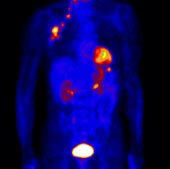| PET Scan For » Cancer |
|
|
 |
PET Scans and Cancer
PET can help physicians effectively pinpoint the source of
cancer. This is possible because many cancer cells are
highly metabolic and therefore synthesize the radioactive
glucose (sugar) that is injected in the patient prior to the
exam. The areas of high glucose uptake are dramatically
displayed in the scan imagery, as opposed to the anatomical
imagery of CT or MRI, which cannot detect active, viable
tumors.
|
If cancer is
found early, it can often be cured. A PET scan can be
used in early diagnosis, assisting physicians in
determining the best method for treatment. A whole body
PET scan may detect whether cancer is isolated to one
specific area or has spread to other organs before a
treatment path is determined.
Approximately 1,372,910 new cancer cases are expected to
be diagnosed in 2010. According to the American Cancer
Society, approximately 570,280 Americans are expected to
die of cancer this year, more than 1,560 people per day.
What is Cancer?
Cancer comes in a variety of forms. Basically,
cancer occurs when cells in the body begin to grow
chaotically. Normally, cells grow, divide, and produce
more cells to keep the body healthy and functioning
properly. Sometimes, however, the process goes astray;
cells keep dividing when new cells are not needed. Some
types of cells are more prone to abnormal growth than
others. The mass of extra cells forms a growth or tumor,
which can be benign or malignant.
Benign tumors are not cancer. They often can be removed
and, in most cases, they do not come back. Cells in
benign tumors do not spread to other parts of the body.
More importantly, benign tumors are rarely life
threatening.
Malignant tumors are cancer. Cells in malignant tumors
are abnormal and divide without control or order. These
cancer cells can invade and destroy the tissue around
them. In a process called metastasis, cancerous cells
break away from the organs on which they are growing and
travel to other parts of the body, where they continue
to grow. Cells from cancerous ovaries, for example,
commonly spread to the abdomen and nearby internal
organs. Eventually, they can invade the bloodstream and
lymph system (the two systems of vessels that bathe and
feed all of the body's organs) and travel to organs
throughout the body. Metastasis is how cancer
"colonizes" to produce new tumors within the body. |
|
|
|
|